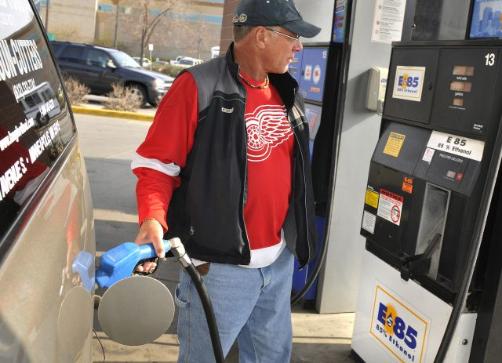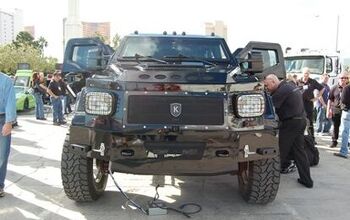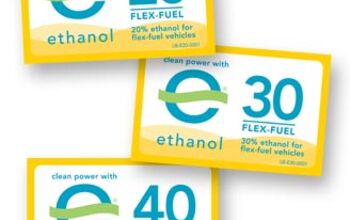E85 Boondoggle of the Day: Blenders' Last Stand
The E85 industry is tanking. Despite federal mandates designed to foist the fuel on a suspecting public, and Transportation Secretary Chu’s determination to make all new vehicles Flex-Fuel capable (EPA credits for everyone!), the E85 industry is on the brink of extinction. Consumer demand (such as it wasn’t) is plummeting. Meanwhile, environmentalists threaten to expose the corn-for-fuel process as, gasp, carbon-positive. Evidence of pumps with ten-foot pole marks comes to us from Minnesota, the state with the highest number of E85 outlets in the land. Here’s the Star Tribune’s report, which can’t resist using the boosterrific term “clean burning” whilst charting the corn-based fuel’s demise:
In February, sales of E85, a cleaner-burning fuel consisting of 85 percent ethanol and 15 percent gasoline, hit their lowest mark since 2006, according to a new report by the Minnesota Department of Commerce. Sales, which bottomed out around 1 million gallons per month, started to rebound this spring but are still lagging last year’s numbers.
In May, about 1.5 million gallons of E85 were sold — almost 1 million gallons less than in May 2008.
Subtract various initiatives forcing government workers to use corn juice, lose the numerous “promotions” used to fuel demand (which account for this picture), drop the subsidies and tax credits (God forbid) and the full extent of E85’s retreat is clear. In fact, it’s looking more and more like a rout.
Corn-for-fuel’s last stand is buried in the Climate Change Bill, as the New York Times reports, whilst kvetching about compromise.
Democratic leaders should nevertheless resist calls to weaken the targets on emissions reductions. The House bill is itself a compromise, and a weaker Senate bill could be worse than no bill at all.
The Senate should also remove the House version’s more glaring defects. Among these is a provision — inserted at the insistence of the farm lobby — that would postpone a systematic accounting of the carbon emissions from biofuels like corn ethanol. The farm lobby and its allies on the Agriculture Committee are clearly nervous that the accounting would cast corn ethanol in an unfavorable light.
As in reveal the truth. Can’t have that, now can we? Given that Archer Daniels Midland was a big supporter of our current president’s presidential aspirations ( flew him around on their jet), look for this boondoggle to die another day. Unless and until the feds force motorists to fill-up on E85, or E15, it’s a dead blend slouching towards Bethlehem.
More by Robert Farago
Latest Car Reviews
Read moreLatest Product Reviews
Read moreRecent Comments
- ToolGuy First picture: I realize that opinions vary on the height of modern trucks, but that entry door on the building is 80 inches tall and hits just below the headlights. Does anyone really believe this is reasonable?Second picture: I do not believe that is a good parking spot to be able to access the bed storage. More specifically, how do you plan to unload topsoil with the truck parked like that? Maybe you kids are taller than me.
- ToolGuy The other day I attempted to check the engine oil in one of my old embarrassing vehicles and I guess the red shop towel I used wasn't genuine Snap-on (lots of counterfeits floating around) plus my driveway isn't completely level and long story short, the engine seized 3 minutes later.No more used cars for me, and nothing but dealer service from here on in (the journalists were right).
- Doughboy Wow, Merc knocks it out of the park with their naming convention… again. /s
- Doughboy I’ve seen car bras before, but never car beards. ZZ Top would be proud.
- Bkojote Allright, actual person who knows trucks here, the article gets it a bit wrong.First off, the Maverick is not at all comparable to a Tacoma just because they're both Hybrids. Or lemme be blunt, the butch-est non-hybrid Maverick Tremor is suitable for 2/10 difficulty trails, a Trailhunter is for about 5/10 or maybe 6/10, just about the upper end of any stock vehicle you're buying from the factory. Aside from a Sasquatch Bronco or Rubicon Jeep Wrangler you're looking at something you're towing back if you want more capability (or perhaps something you /wish/ you were towing back.)Now, where the real world difference should play out is on the trail, where a lot of low speed crawling usually saps efficiency, especially when loaded to the gills. Real world MPG from a 4Runner is about 12-13mpg, So if this loaded-with-overlander-catalog Trailhunter is still pulling in the 20's - or even 18-19, that's a massive improvement.


































Comments
Join the conversation
From:http://network.nationalpost.com/np/blogs/francis/archive/2008/04/04/obama-energy-policy-is-best-of-three.aspx "A new book, called “Energy Victory”, debunks these myths and makes the scientific case in favor of ethanol. It s written by scientist/engineer Dr. Robert Zubrin, a NASA consultant and researcher in Colorado. The book analyzes the energy input myth, citing the most recent and authoritative study, in Science Vol. 311 in January 2006: ethanol production requires one-tenth the amount of energy inputs as does gasoline production. (Sugar cane is a more efficient feedstock than corn used in North America, but corn is still dramatically more beneficial than crude-oil fuels.) Likewise, he maintains the subsidies are also mythology by lobbyists. Last year, for instance, he said the U.S. produced eight billion gallons of ethanol and the 50-cent subsidy cost taxpayers US$4 billion. But the eight billion gallons replaced the need to import US$20 billion worth of crude oil. By including all figures, the subsidy becomes an investment in saving billions."
@retroman I realize you are getting paid by the ethanol industry to astroturf the internet with their propaganda. Hey, if that is what puts bread on the table...so be it; there are far worse things you could be doing. ...ethanol production requires one-tenth the amount of energy inputs as does gasoline production. Half-truth: Sure, if you conveniently leave out all the other things which come out of a barrel of oil during refining. Sugar cane is a more efficient feedstock than corn used in North America truth: yes, sugar cane is more efficient (too bad it does not grown in the midwest). Opinion: ...but corn is still dramatically more beneficial than crude-oil fuels.) Lie: Likewise, he maintains the subsidies are also mythology by lobbyists. Ethanol is heavily subsidized meaningless statement: Last year, for instance, he said the U.S. produced eight billion gallons of ethanol and the 50-cent subsidy cost taxpayers US$4 billion. But the eight billion gallons replaced the need to import US$20 billion worth of crude oil. By including all figures, the subsidy becomes an investment in saving billions. How are taxpayer subsidies for ethanol related to the value of imported oil?